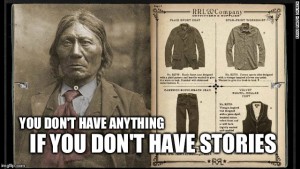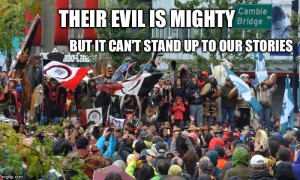
Image taken from controversial 2014 Ralph Lauren ad shared on Twitter via the hyperlink attached to the image. This image was chosen to show how modern casual cultural genocide is still present in our society. Text added, see below.

Image taken from the Vancouver Media Co-op’s coverage of the 2013 Truth and Reconciliation March via the hyperlink attached to the image. This image was chosen to represent the strength of modern indigenous groups to stand up for their rights and cultural identity in the face of forced assimilation. Text added, see below.

Image taken from Squamish Lil’wat cultural center website via the hyperlink attached to the image. This image was chosen to provide one of many examples of how indigenous culture is still thriving and advancing in the territories it did for thousands of years before European settlers arrived. Text from Leslie Marmon Silko (Laguna Pueblo) as recorded in the book Coded Territories.

After watching this video for the first time, I admit, I had a great deal of difficulty deciphering the message behind the medium. Even after reading the excerpt from Coded Territories about the piece, while I certainly understood the methodology, it was not until the class discussion and a closer look at the reading that it began to become clear to me. Clearly, this installation is a heavily layered piece with the intention of conveying a great deal through these discordant sounds. Walter Benjamin’s “Theses on the Philosophy of History” was quoted as follows:
To articulate what is past, [does not simply mean] to recognize ‘how it really was,’ it means to take control of a memory, as it flashes in a moment of danger.
Postcommodity is accomplishing much more here than simply conveying a message translated from another time. By translating it into this format, these artists are changing the narrative and actively contributing to the stewardship of this knowledge for the community in Santa Fe. They are able to “negotiate cultural space” (from the excerpt provided on connect) within the current era to provide a narrative to the events that occurred when the town of Santa Fe “essentially fell out of history” (Coded Territories) in terms of how history is traditionally understood in Western cultures. That is to say, this group has created a narrative that represents and advances indigenous understanding of this key period in time when Settler culture and ‘civilization’ was renounced and an attempt to reclaim cultural and physical territory was made and then held for twelve years after nearly eighty years of oppression according to Coded Territories. To me, this highlights the relevance of indigenous artists working with all kinds of media.
What Postcommodity and others are doing to not only preserve historical cultural knowledge, but also to carefully and painstakingly translate it into a media that can be understood in the current cultural context is a stunning act of decolonization and cultural sovereignty. Their contribution, through their art, has enriched and fundamentally changed the dialogue around indigenous life and culture for all those who are effected by this piece or by those influenced by it. This ripple effect is emulated by all of the other artists and artisans working within this field. Their propagation and translation bridges the gap between cultures and times. While some may say that perception of history is based on our weapons, maybe it is time to challenge that analysis.
In this information era, could it not be instead stated that history moves at the speed of its words? Propaganda and censorship have long been a part of the international discussion around individual freedoms and liberties. Now that more and more time is spent by millions of individuals in an online space that can be more directly monitored and controlled than at any time before, perhaps it is the words, sounds, and images that will define our understanding of the progression of history rather than the analog weapons we decreasingly bare. Or perhaps the pen has become the sword?
 Follow
Follow